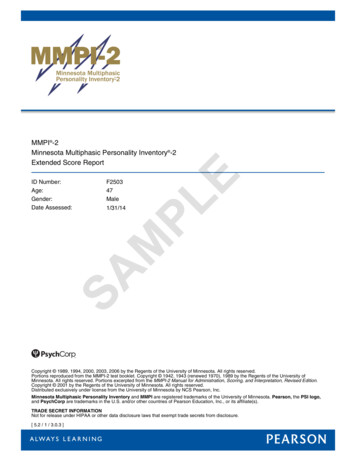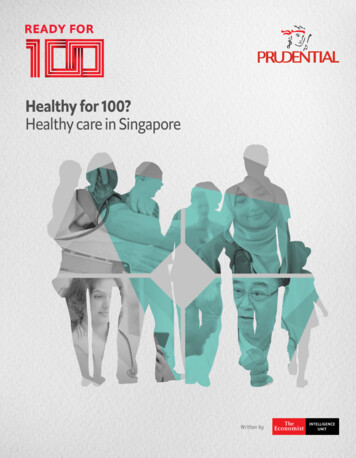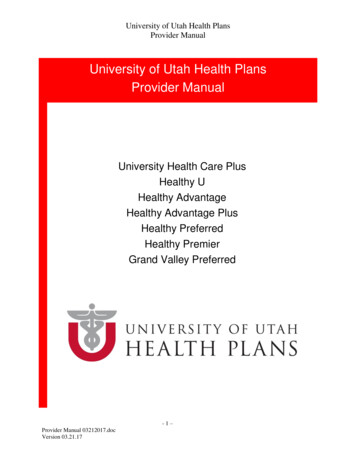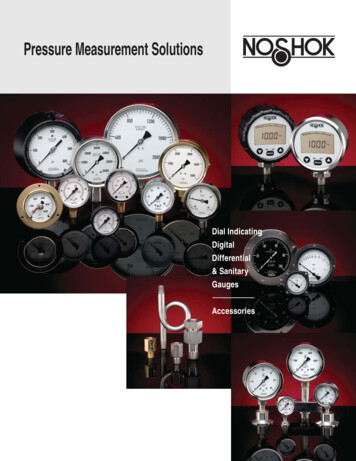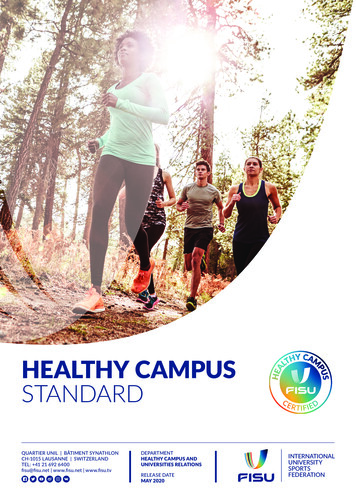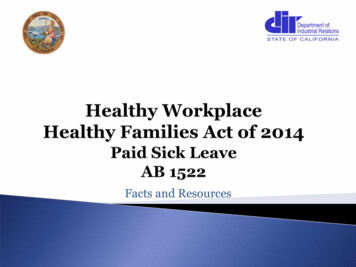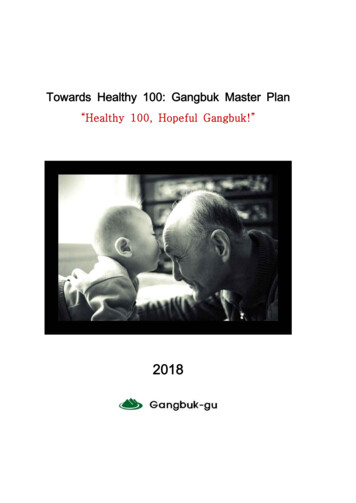
Transcription
Towards Healthy 100: Gangbuk Master Plan“Healthy 100, Hopeful Gangbuk!”2018
We submit this report of Towards Healthy 100: Gangbuk MasterPlan to join the WHO Global Network for Age-friendly Citiesand Communities2018. 1. 2.Mayor of Gangbuk-guPark, Gyum-soo
Table of Contents1. Introduction ················· 11.1 What Is the Age-Friendly Cities (AFC)? ········ 11.2 Why We Need AFC project? ··· 31.3 What We Have Done for AFC? ······················ 61.4 Organization for AFC Gangbuk ························ 82. Evaluation of Gangbuk’s Age-Friendliness ········ 112.1 Local Status of Gangbuk District ··················· 112.2 Results of 2016 Injury Status Survey ·········· 172.3 Results of 2017 Age-friendliness Survey ·· 282.4 Discussion ········ 403. Prioritization and Primary Task Selection ·········· 453.1 Value of AFC Gangbuk ·········· 453.2 Reviewing Data concerning Age-friendliness ······················· 473.3 Methods of Prioritization (BPRS-PEARL) ···· 493.4 Primary Task Selection ··········· 504. Strategies of AFC Gangbuk ········· 554.1 Five Main Issues ······················ 554.2 Strategies to Solve the Problems ················· 734.3 Deriving Six Major Projects ··· 755. Aims and Objectives of AFC Gangbuk ·············· 835.1 Aims of AFC Gangbuk ············ 835.2 Objectives of Six Major Projects ··················· 86
6. Execution Plan for Six Major Projects ··············· 936.1 [Transportation] Obstacle-free Roads Project ······················ 936.2 [Housing] Integrated Support for Gyeonrodangs ················ 996.3 [Respect and Inclusion] Dementia-friendly Village ··········· 1046.4 [Participation and Employment] Jobs & Social Participation Project ··· 1126.5 [Health Services] Suicide Prevention Project ···················· 1206.6 [Health Services] Home Care Service ······· 1267. Execution Plan for Other Projects ····················· 1317.1 Transportation · 1337.2 Housing ············ 1397.3 Respect and Inclusion ··········· 1487.4 Participation and Employment ······················ 1607.5 Health Services ······················· 174References ·················· 191
1Introduction1.1 What Is the Age-Friendly Cities (AFC)? The idea of AFC is based on the concept of active ageingframework proposed by the World Health Organization gopportunities for health, participation and security in order toenhance the quality of life as people aged (WHO, 2007). Figure 1-1 Determinants of Active Ageing (WHO, 2007)- 1 -
According to the WHO’s report (2007) of Global Age-FriendlyCities: A Guide, active ageing is determined by various factors.It means that not only individual efforts but also comprehensiveand collective efforts from community are needed to accomplishone’s active and healthy ageing. Figure 1-2 WHO’s Global Network of AFC (WHO, 2017) Meanwhile, WHO have insisted that globally organized efforts isurgently needed to overcome the issues of ageing populationand urbanization since 2000. As an illustrative example, WHOproposed the Global AFC project for the first time at the XVIIIWorld Congress for International Association of Gerontology .Following up, WHO conducted Target group interviews with1,458 people from 33 cities around the world and organized the- 2 -
results to publish Global Age-Friendly Cities: A Guide (2007). Itwas the WHO’s initiative in forming the Global AFC network tooffer technical support on AFC members and running itsintelligent network to exchange information. Currently on June 2017, about 500 cities from 37 countriesparticipate in the WHO’s AFC network (whose population wouldbe about 150 million). As for Korea, 6 cities (i.e., Seoul,Jeongeup, Pusan, Suwon, Jeju, Gwangju Dong-gu) alreadyparticipated in the AFC network. Gangbuk is a small districtlocated in Seoul populating 320 thousand, and it will be the 7thapplicant from Korea to join the AFC network. It will bemeaningful that this is the first proposal to join the AFC globalnetwork from a municipal government in Seoul, South Korea.Because, activities of daily living and quality of life would mostlybe affected by the environment of smaller community, ratherthan that of mega-city.1.2 Why We Need AFC Project? AFC is in alignment with the WHO’s Healthy Cities or theWHO Safe Communities movement. Healthy Cities projects wasemerged from the WHO’s declaration in Alma-Ata - Health forAll - then from the New Public Health Movement in 1980s. SafeCommunities project is based on the Stockholm Manifesto,- 3 -
adopted by resolution at the 1989 conference: All human beingshave an equal right to health and safety. They both aim tostrengthen the community’s capacity for the goal of everyone’shealth and safety. Figure 1-3 Official Approval of Safe Community Gangbuk by WHO(May, 2013) After that, it was rapidly acknowledged that building structurefor enhancing community health is important and the HealthCities projects was firstly implemented in Europe and NorthAmerica. Then the project was expanded to the Western PacificRegions to start global network of Alliance for Healthy Cities- 4 -
(AFHC), where 175 cities from 9 countries have participated. Asof now, number of total cities working on Healthy Cities projectis about 1,000 that participant cities are on steady increase. Figure 1-4 Joining the AFHC General Assembly Network (August,2016) Based on these global trends, Gangbuk was officially approvedas one of the Global Safe Communities by the WHO on May2013. Gangbuk was also chosen to be an Excellent District ofSafe Community by the metropolitan government of Seoul buk also joined the WHO’s affiliated organization of AFHCto continuously participate in the global network aiming for- 5 -
healthy and safe cities. Gangbuk is deeply sympathizing and agree with the WHO’sreport (2007) that ageing population and urbanization is one ofthe most important agenda for the world which could be solvedonly by the globally organized effort. Actually, Gangbuk is oneof the district which is the highest old-age population ratioamong entire districts of Seoul. In 2013, old-age population ratiowas already reached to 14.1% in Gangbuk, that it has beencategorized as an aged society. By 2021, it will be expected tobecome super-aging society, which the ratio exceeds 20%.Currently as of the end of October 2017, our population over65 years old was 56,078 and the old-age population rate wasreached as much as 17.0%. In summary, Gangbuk is willing to participate in the GlobalNetwork of AFC where the WHO’s technical supports areaccessible and the cities and communities could exchange theirexperiences. Throughout this, we are willing to join the WHO’smovement for Age-Friendly World.1.3 What We Have Done for AFC? Once Gangbuk set its policy vision as Healthy 100, Hopeful- 6 -
Gangbuk, we have reviewed survey data for our resident’sage-friendliness. Also, we have made various efforts to createage-friendly environment for the past 10 years. These activitiesare listed below in summary. Table 1-1 Activities towards AFC GangbukYearContents2008.Conducting the Community Health Survey (every year)Conducting the Health-friendly Village Making Project2012.5.2013.9.2015.1.Composing the official ‘Healthy City Project’ team2015.2.Conducting the 2015 Survey for Living Alone Elderly2015.4.2015.9.Participating in the 9th General Assembly of KHCP2015.9.Joining the membership of KHCP (2015. 9. 17.)2016.7.(148 bunji, Bun-2-dong, Gangbuk-gu)Legislating the Basic Regulation for the Senior Welfare,Gangbuk (2013. 9. 27.)Participating in the 15th Extraordinary General Meeting ofKorean Healthy Cities Partnership (KHCP)Legislating the Regulation for Healthy City, Gangbuk (2015.7. 15.)Participating in the 7th General Assembly of Global Network2016.8.of Alliance for Healthy Cities (AFHC) and joining themembership of AFHC2016.8.Conducting the 2016 Survey for Living Alone Elderly2016. 10.Benchmarking other cities of AFC2017.4Reviewing the local data for Age-friendly status2017.5.2017.7.Conducting the 2017 Living Profiles of Ganngbuk OlderPeople SurveyConducting the 2017 Survey for Living Alone Elderly- 7 -
1.4 Organization for AFC Gangbuk1.4.1 Organization of AFC GangbukMunicipalGovernment ofGangbuk-guAFC CommitteePartneshipAdvisory PanelAFC Task ForceAgenda Setting and ung-Kong-HoeUniversityProgram ImplementationŸŸŸŸŸŸŸVision and MissionDiagnosis and EvalutionAgenda and Selecting Primary TaskCommunity ConsensusDiffusion, Advertisement, Public IssuesCommunity EventsCommunity EngagementFinancing/FundraisingŸAFC Vision and MissionReviewing data of Age-friendly statusAFC GuidelineAFC Executive PlanAFC Evaluation and MonitoringLong-term PlanningPartneshipbetweenCentralandMunicipal GovenmentReviewing Law and Regulation Figure 1-5 Organization System for AFC Gangbuk- 8 -
1.4.2 Work Force of AFC Gangbuk Table 1-2 Work Force System for AFC GangbukRolePositionResearch Professor, Institute of Social Welfare,Sung-Kong-Hoe UniversityResearch Professor, Institute of Social Welfare,AdvisoryPanelSung-Kong-Hoe UniversityResearch Fellow, Institute of Social Welfare,Sung-Kong-Hoe UniversityProfessor, Department of Nursing, SungshinUniversityA Deputy Mayor, Municipal Government ofGangbuk-gu DistrictHead of Administration Management, MunicipalGovernment of Gangbuk-gu DistrictDirector of Bureau of Planning and Fiance,Municipal Government of Gangbuk-gu DistrictDirector of Bureau of Resident Living,Municipal Government of Gangbuk-gu DistrictDirector of Bureau of the City Management,Municipal Government of Gangbuk-gu DistrictDirector of Construction, Safety, TransportationBureau, Municipal Government of Gangbuk-guAFCTask ForceDistrictSecretary General, A Ward Assembly ofGangbuk-guDirector of Public Health Office, MunicipalGovernment of Gangbuk-gu DistrictChief of Local Economy Department, MunicipalGovernment of Gangbuk-gu DistrictChief of Elderly Welfare Department, MunicipalGovernment of Gangbuk-gu DistrictChief of Green City Department, MunicipalGovernment of Gangbuk-gu DistrictChief of Traffic Administration Department,Municipal Government of Gangbuk-gu DistrictChief of Local Public Health Department,Municipal Government of Gangbuk-gu District- 9 -NameChang-O KimYeon A, KimDawoon HyunKyung-choon LimHae-young OhSang-hyung LeeYong-in YoonMyung-soo JungDong-il LeeHee-dong KimYeon-wook JungIn-young LeeKil-yong JungMi YoonWoon-shik KimByung-yoon KimEun-kyung Jung
- 10 -
2Evaluation of Gangbuk’s Age-Friendliness2.1 Local Status of Gangbuk District2.1.1 General Status Administrative Area StatusŸThe area of Gangbuk district is 23.61 which amounts to3.9%ofSeoulMetropolitanCity(605.52 ).Currently,141,165 households and 329,042 people inhabit in Gangbukdistrict’s administrative units consist of 13 gu, 384 tong,3,333 ban (2.29 population per household).ŸIts financial self-reliance rate is 18.8% which ranks 24thamong 25 districts, and financial independence rate is47.1% which ranks 22nd. Population StatusŸOn October 2017, among Gangbuk’s 329,042 populationselderly population over 65 years old are 56,078 (female56.9%, male 43%) which amounts to 4.1% of Seoul’s- 11 -
elderly population. Among 25 districts, it has one of thehighest old-age population ratio (17.0%) that its role of AFCis especially called for.ŸSeeing our population by age group, the 50s are mostcommon accounting for 16.8% (55,243 people), then the40s 16.4% (54,075 people), followed by the 30s 14.2%(46,817 people). Based on these numbers, it is easilyexpected that the entry rate of its elderly population will beswift, which calls for sound elderly welfare policies and AFCenvironment.(unit: person, 2017. 9.)- 12 -
Status of the Elderly living AloneŸAs of the end of 2016, there were 13,760 elderly livingalone in Gangbuk, which was as large as 24.5% of theelderly population 65 or older (52,309). Among the elderlyliving alone (Single Elderly), the portion of female SingleElderly (9,526 / 69.2%) was significantly greater than that ofmale (4,234 / 30.%).Ÿ28.5% (3,926) of the Single Elderly were in the low-incomebracket. 20% (2,750) were the eligible recipient of second-lowest income bracket. It was found that the femaleSingle Elderly were exposed to poverty in a greater degree- the rate of female, low-income Single Elderly was 72.6%of all low-income Single Elderly.(unit: person, 2016.)- 13 -
2.1.2 Ageing Trend Average Age, Birth Rate and Mortality ation is 43.9 years old (41.5 for Seoul), i.e, 2nd highestin Seoul following Jung district (44.1).ŸIts birth rate is 6.1% (7.7% for Seoul), i.e., 2nd lowestfollowing Jongno (5.7%) among 25 districts of Seoul, and itsmortality rate is the highest at 5.7% (4.4% for Seoul). Suicide RateŸGangbuk has the highest rate of suicide in Seoul - 30.6persons per 100,000 (45.3 male and 16.4 female). In 2016alone, 99 Gangbuk residents committed suicide, and 31.3%of them (31 persons) were the elderly 60 or older. In termsof the gender, the suicide rate of male elderly (23 persons,74.2%) was significantly higher than that of the female (8persons, 25.8%).ŸThe poor elderly has become a well-known problem. 77.4%(24 persons) of the elderly who committed suicide wereunemployed. The suicide rate of those in their 50s, thosewho are about to reach their retirement ages, reached28.3% (28 persons). Such high suicide rates have alerted- 14 -
the adults to prepare for their post-retirement life.(unit: person, 2016) Old Dependency Ratio (ODR) and Aged-Child Ratio (ACR)ŸOn September 2017, Gangbuk’s ODR is 23.3% and itsACR is 173.2 (118.0 for Seoul).ŸOn February 2016, Seoul announced its future tatistics,Gangbuk’s ODR is expected be on the rise to 49.9% bythe year 2033 from 20.4% on 2015. That ranks for thehighest among the 25 districts of Seoul (expected ODR forSeoul is 39.8%).- 15 -
(unit: %, year)ŸGangbuk’s ACR is also expected to be steadily on therise. ACR is estimated to be 322.2 by the year 2033 from131.7 on 2015. Among 25 districts of Seoul, it has rankedto be the 2nd highest following Jung-gu (expected ACR forSeoul is 227.8).(unit: %, year)- 16 -
2.2 Results of 2016 Injury Status Survey Gangbuk has been steadily trying to raise the residents’awareness on safety and to reduce the damages from accidentssince 2008 (when it started the Safe City Project) and it wascertified as the WHO International Safe Community in 2012. As a part of such efforts, Gangbuk has published the 2016Injury Status Survey Report in 2016, which described thedamages suffered by the residents of Gangbuk-gu, such asdeath, injury and accidents. This Report which contains therelated data from 2013 to 2015 reviews major strategies ofGangbuk on reducing the damages in the community, such asidentifying the causes and environments that threaten the safetyof residents and reviewing the status of damages suffered byand the risks that threaten the high-risk, vulnerable class (e.g.infants, children and elderly). In this section, we will introduce the issues related to theawareness of safety by the elderly 65 or older. Also we willshow the recent data concerning suicide commited by olderadults living in Gangbuk district.- 17 -
2.2.1 Causes of Injuries to the Elderly One of the major causes of injury for the elderly residing inGangbuk district was falling. The review of recent three years’data from the Gangbuk Elderly Damage Monitoring Systemrevealed that the injury by slip and/or fall was the biggestcause in every year. The second biggest reason was trafficaccident in 2013, puncture or laceration in 2014 and collision(excluding others) in 2015. 2013 2014 2015Crash/slip transportaccidentsbumpsBurn/firebepricked/cutfall into addiction otherswater In terms of causes of damages per type of location, the slipand/or fall were the biggest cause in all locations (includinghomes) in 2015. In 2014, the slip and/or fall; the trafficaccidents; puncture or laceration; and burn by fire were thebiggest causes, respectively, in homes, group facilities and- 18 -
in/outdoor cultural facilities; roads; work places; and commercialservice areas. This shows that the environment improvementprojects aimed at protecting the elderly from falling injury mustbe implemented not only in their homes, but also in all placesthey frequent, such as the group or cultural facilities and in theline of their movement.2.2.2 Awareness on Safety In terms of the elderly’s awareness on safety, it was found thatthe elderly in Gangbuk district were most concerned with (inorder) the slip and/or fall, the traffic accidents and the accidentscaused by gas and/or electricity. 27.4% of respondents saidthat they had suffered from falling, and 70% said that they hadincidents where they could have suffered from falling. As far asthe elderly were aware, their surroundings were not as safe asthey expected them to be.- 19 -
Meanwhile, the rate of participation in safety training programsby the elderly was low. The rates of: participation in ation protection equipment was 9.7% - the elderly werenot interested in taking preventative action which require theirown efforts.ŸMore female elderly experienced falling, feared for falling,used ambulation protection equipment, considered takingthe prescribed medicine and received vision examination;and more male elderly regularly participated in falling injuryprevention exercise programs.ŸThe rates of the elderly experiencing falling, fearing nsidering taking prescribed medicine were greater inthose 75 or older; and the rates of the elderly whoreceived vision examination and regularly participated infalling injury prevention exercise program were greater inthose younger than 75.ŸWhen considered both gender and age, the female elderly75 or older had high rates of experiencing falling or fear offalling, while their rate of regularly participating in fallinginjury prevention exercise program was the lowest.- 20 -
cribed medicine and 70.7% received vision examination this shows that the elderly were highly dependent on medicalinstitutions. Male Female Totalunder 75over 75Totalunder 75Experience rate ofExercise program for fall preventionunder 75over 75Totalunder 75Use rate ofWalking protection equipmentunder 75over 75TotalUse rate of Walking aidsover 75Use rate ofDoctor's Drug Reviewover 75Experience rate of eyesight test- 21 -TotalTotal
2.2.3 Safe Environment Then, in what living environment do the elderly live? Whenreviewed the falling injury cases occurred inside homes: thebathroom floor was slippery in 21.4% of cases; no safety railwas available in the bathtubs or wash basins in 87.3% ofcases; and there were objects in the hallways that could causeone to trip over in 24.6% of cases. In 38.5% of cases, therewere door sills or steps, no light was installed in the staircase(in 25.4% of cases) and the handrails in staircases were not onboth sides of the walls (in 60.2% of cases). While it isnecessary to improve the overall conditions of the elderly’sliving environment, it is especially important to improve theoverall conditions of the Single Elderly and female low-incomeelderly whose numbers are greater than others. Yes NostairsThe stair handles are on both sides.The lamp is installed.inside the houseThere is a thresholdand a small staircase.There is something that can fall downif you hit the aisle.The lighting is bright.bathroomThe safety handle isinstalled in the bathtub and washstand.The floor is not slippery.- 22 -
The rate of the elderly in Gangbuk suffering from trafficaccidents was lower than those of entire Korea or Seoul. Whilethe number of traffic accidents involving the elderly steadilyrose in Korea and in Seoul, that in Gangbuk rose from 473cases in 2013 to 553 cases in 2014 and dropped to 543 in2015.(unit: Occurrence count)Nationwide2013SeoulGangbuk20142015 The rate of injury by traffic accidents rose from 14.6 in 2013to 16.7 in 2014 and 16.2 in 2015. The annual rates of trafficaccident in the past three years were lower than those ofKorea and Seoul. In terms of type of traffic accidents, the mostfrequent type of accidents was car-to-car accidents, followed bycar-to-person and by car-alone (in order).- 23 -
(unit: person per thousand population) Nationwide Seoul Gangbuk201320142015 74.7% of the elderly 65 or older wore seat belts, 10.3% wheeled vehicles while they were drunk. 94.7% used roadcrossings and/or overpasses, 92.2% said they complied withroad crossing signals, and 83.8% said they got off the busesafter the buses completely stopped. Meanwhile, the rate of participation in safety training was verylow, at 15.5%. 61.8% of the respondents answered that theywere not interested in participating in any event related tosafety, and 51.7% answered that the safety training would notbe useful. The rate of wearing bright-colored cloths at nightwas also very low, at 6.5%. It is necessary to develop the- 24 -
training programs focused on satisfying the specific needs ofand inviting the elderly to participate.2.2.4 Awareness on Suicide uk-gu was 3.49. 68.1% (325 persons) were normal,21.0% (100 persons) had light symptoms of depression and10.9% (52 persons) had serious cases of depression.Depression score perceivedby elderly in GangbukDepression rateof elderly people in Gangbuk 3.8% and 0.8% of the elderly, respectively, thought aboutcommitting suicide and have ever prepared to commit suicide.Major reasons for doing so were: worsening health (60.0%) andrelationship with family and friends (20.0%).- 25 -
Male Female Totalunder 75over 75TotalSuicidal Thought RateReasons to think about suicide The greater the degree of depression, the greater the rates ofthinking about committing suicide and having prepared to ly,showed the highest rates of thinking about committing suicideand having prepared to do so, which attracted my attention. Male Female Totalunder 75over 75TotalRecognition rate of Where to ask for helpwhen you have suicidal thoughts- 26 -Where to ask for helpwhen you have suicidal thoughts
Only 31.4% said that they knew a place they could ask forhelp when thought about committing suicide. 77.2% of therespondents said ‘119 (Korea’s public emergency call number)’was a place they would ask for help when they thought aboutcommitting suicide - the dependence on the local community,including families and neighbors, was significantly low.SummaryŸThe biggest cause of injury for the elderly residing in Gangbuk-guwas falling. While it is necessary to improve the overall conditions ofthe elderly’s living environment, including their homes and living,group activity and cultural facilities, it is especially important toimprove the overall conditions of the Single Elderly and femalelow-income elderly.ŸWhile improvement of the environment to prevent the elderly fromgetting injured by falling was found to be important, the rate of theelderly participating in falling injury prevention programs was verylow. For example, the elderly heavily relied on the hospitals to getprescriptions for medicines and vision checks, but hardly everparticipated in the activities aimed at preventing the falling injurywhich required their voluntary efforts during daily life. A review oftraining method and access to training seems necessary.ŸThe rate of the elderly who had ever participated in traffic safetytraining was also very low, at 15.5%. More than half of the elderlywho participated in the survey said that they were not interested inparticipating in the safety training events and they didn’t think suchevents would be helpful. Seen from the perspective of educationalvalue, it is necessary to develop training programs which are- 27 -
customized to the elderly and promote the elderly to participate.ŸMeanwhile, only 31.4% knew where to ask for help when theythought about committing suicide. 77.2% of the respondents said‘119’ was a place they would ask for help when they thought aboutcommitting suicide - the dependence on the local community,including families and neighbors, was significantly low.2.3 Results of 2017 Age-friendliness Survey2.3.1 Survey Overview The 2017 Age-friendliness Survey was conducted to evaluateliving trends of elderly residing in Gangbuk, using the eightareas suggested by the WHO Guideline. We tried to understandhow can we create a local environment which is friendly to theelderly, especially in the areas of health, comfortable living andlocal community. This Survey was conducted on 1,000 elderly 60 years or olderresiding in Gangbuk district in May, 2017. Contents of thequestionnaire was listed as described in Table 2-3.- 28 -
Table 2-3 Contents of the 2017 Age-Friendliness SurveyCategoriesContentsNumber ofQuestionsStatus of OldAge PreparationHealth, old-age fund preparation, social activityparticipation, hobby or leisure activities, andjob skill improvement preparation5Health StatusSubjective health status1LivingEnvironmentCommunityActivitiesSocial InclusionGeneralCharacteristicsResidential convenience: whether havingexperienced fall before, place of fallTransportation Convenience: whether publictransportation is accessible within 10-minuteradius, and main transportation meansEmployment experience, employment disability,and whether participating leisure or culturalactivitiesWhether having experienced agediscrimination, and subjective possibility ofdying in solitudeAge, gender, income, and income composition223242.3.2 General Characteristics Gender: Male 28.1%,Female 71.9%(n 989, unit: person)- 29 -
Age: 77.1 in average ( 5.8 years old)(n 993, unit: person) Average Monthly Income (including incomes from spouse)personal income after tax and social insurance payment (n 826, unit: 1,000won) Income Composition(n 815, unit: %)- 30 -
SummaryŸThe gender ratio was 28.1% for male and 71.9% for female; theaverage age was 77.1 years old that female elderly facing their 80swere relatively high. Referencing with the elderly population ratio ofGanbuk by the end of 2016 (male 43% and female 57%), thisfemale participant rate is very high that we ought to consider thisfactor in its interpretations.ŸWhile 70.0% of the sujects showed low income level below onemillion won per month, their wage (revenue generating throughlabor) portion of the whole income was low as well. The mainsources of earnings were consist of government subsidy (27.4%),pension (26.1%), private transferred income (16.3%), property income(7.1%), and so forth that non-labor income portion was high (76.9%),whereas earned/business income portion remained just 12.8%.2.3.3 Ageing Readiness Ageing Readiness: 2.56 pointsglobal score 4 (not prepared at all fully prepared)Ageing Readiness StatusAverageAverage d-age fund preparation2.382.2913Preparing for job skill improvement2.141.6857TotalHealth maintenance in doing regularexercises and health check-upsParticipating social activities to maintaininterpersonal relationshipHobbies, and leisure activities- 31 -
global score 4 (not prepared at all fully prepared)Ageing Readiness StatusAverageHealth Maintenance in doing regular2.86exercises and health check-upsParticipating social activities to maintain2.74interpersonal relationshipHobbies, and leisurely activities2.59Old-age fund preparation2.38Preparing for job-skill improvement2.14GenderAverageFemale 2.90Male2.81Female 2.72Male2.77Female 2.51Male2.75Female 2.37Male2.32Female 1.
Once Gangbuk set its policy vision as Healthy 100, Hopeful - 7 - Gangbuk, we have reviewed survey data for our resident’s age-friendliness. Also, we have made various efforts to create age-friendly environment for the pas
